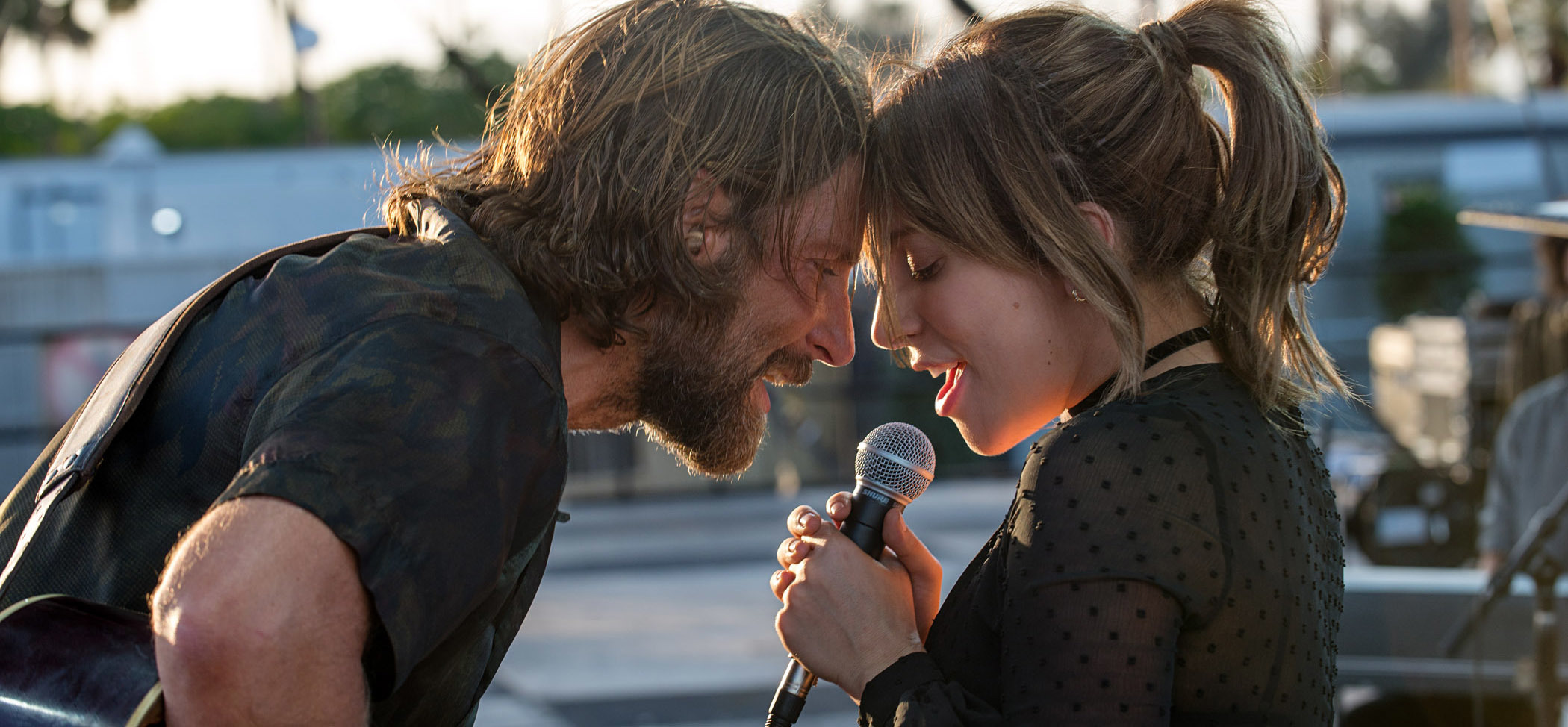
Shooting Stars: A Star Is Born
Matthew Libatique, ASC and director-actor Bradley Cooper reimagine a classic showbiz story.
Matthew Libatique, ASC and director-actor Bradley Cooper reimagine a classic showbiz story.
Unit photography by Neal Preston and Clay Enos, courtesy of Warner Bros. Pictures.
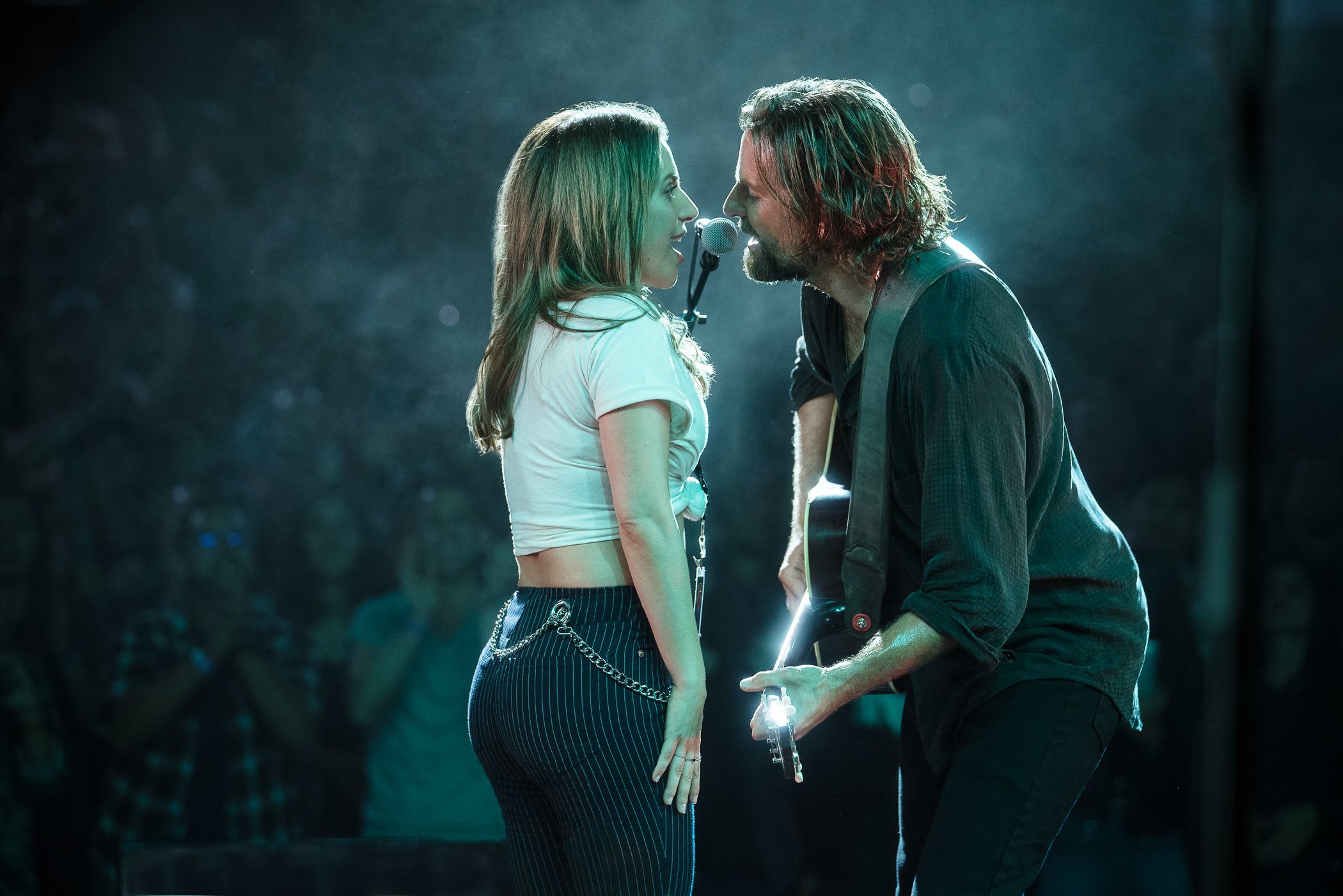
Director of photography Matthew Libatique, ASC was shooting Mother! with longtime collaborator Darren Aronofsky when the director surprised him with some news. “Darren said, ‘Bradley Cooper’s coming up here to talk to you about A Star Is Born,’” Libatique recalls. “It turned out that [Mother! star] Jennifer Lawrence, who had worked with Bradley numerous times, had had a conversation with him because he was looking for a cinematographer, and she was nice enough to recommend me.”
“I’ve always been a massive fan of Matty’s,” Cooper says. “He’s a true artist, and when I asked Jennifer about him, she said he was the best she had ever worked with. After I heard that, I just hoped that he would do it after I met with him and told him my ideas.”
Once Libatique and Cooper got together, they knew immediately that they were in sync. “I definitely had a vision early on, and Matty seemed to really lock onto it,” Cooper remembers. “Shooting [predominantly] in L.A. probably helped, too — maybe he wanted to spend a little time at home.”
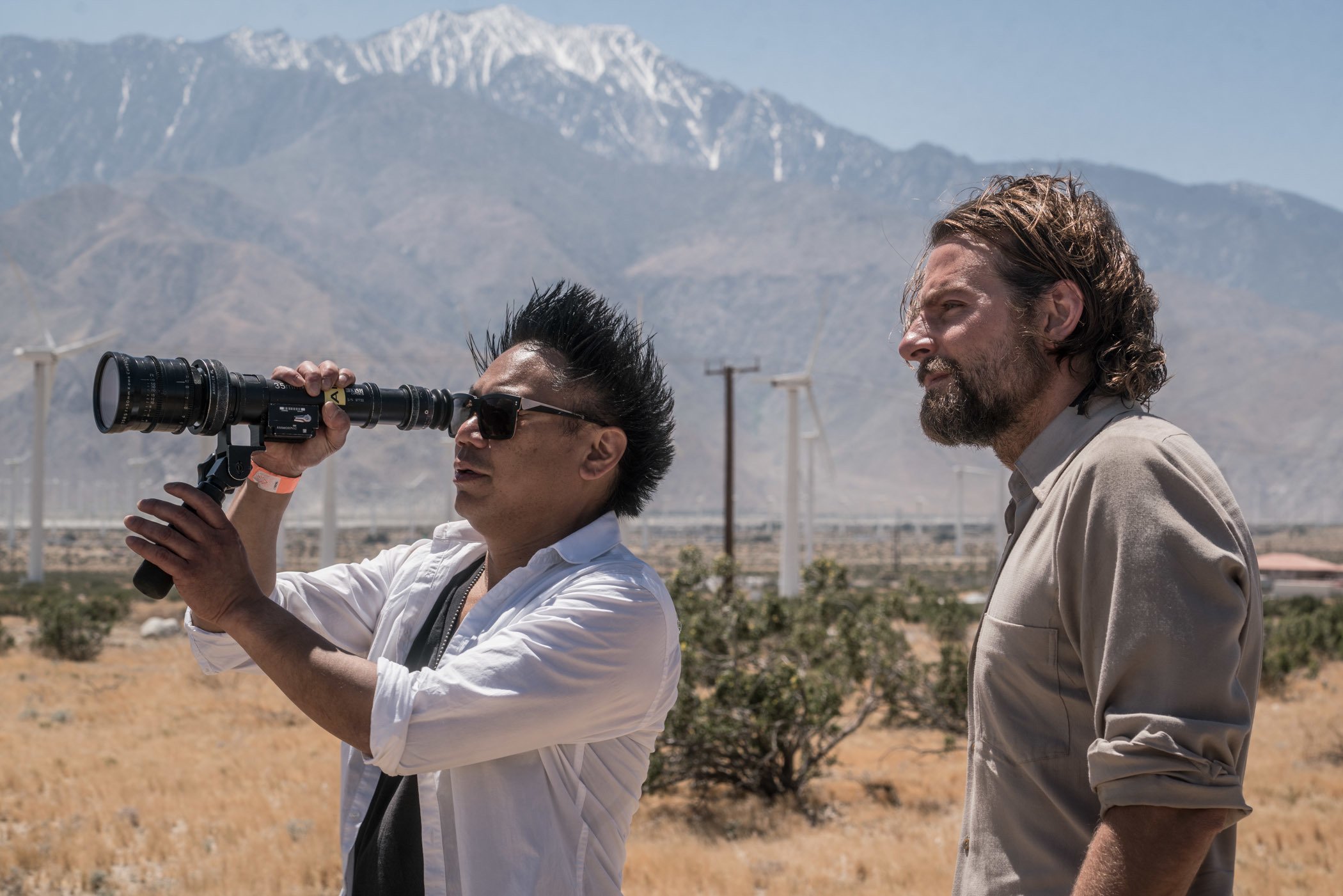
The feature marks Cooper’s first turn in the director’s chair following his longtime work in front of the camera. Prior to his reimagining, A Star Is Born had been put on screen three times: in 1937, directed by William A. Wellman and shot by W. Howard Greene, ASC; in 1954, directed by George Cukor and shot by Sam Leavitt, ASC; and in 1976, directed by Frank Pierson and shot by Robert Surtees, ASC. Like the previous versions, the latest tells the story of a musician who’s on his way down and out when he falls in love with an up-and-coming singer. In this case, the former is Jackson Maine (played by Cooper) and the latter is singer-songwriter Ally (Lady Gaga); their romance is beautiful but doomed, as Ally tries to help Jackson battle his demons without falling victim to them herself.
“We talked a lot about the previous films and how much they were going to be a part of this one,” Libatique explains. “What cues were we going to take from the Judy Garland version [1954] and what cues were we going to take from the Barbra Streisand version [1976]? And what is the tone of our movie? Is it about addiction? Is it about the life of being a rock star? Is it a love story? Ultimately Bradley’s instinct — and I shared it — was that the film is a love story first and foremost, and all the other things create the atmosphere around it.”
The 1954 film, Libatique adds, felt more timeless to him, and it provided a foundation for the relationship between Jackson and Ally, while the musical numbers recalled the 1976 film with Streisand and Kris Kristofferson. “It’s an amalgamation of both,” the cinematographer says.
There were other visual references, too. One that was particularly relevant to Cooper was Martin Scorsese’s Life Lessons — part of the omnibus film New York Stories — which was photographed by Néstor Almendros, ASC. “That was the best movie I knew of that tackled some of the issues I wanted to explore here, and I loved the camera movement in it,” Cooper says. “In that film they did it with a dolly, which we weren’t able to use in our locations — but [camera operator] P. Scott Sakamoto operates a Steadicam as if it’s a dolly. He’s so incredible; he was able to replicate those kinds of moves with total precision.”
The director notes that another Scorsese film, The Last Waltz (photographed by Michael Chapman, ASC), served as inspiration for the concert sequences, and Libatique adds that he and Cooper watched clips from every musical film they could think of, “from Stop Making Sense to Velvet Goldmine.”
The filmmakers’ guiding principle for the concert scenes was to keep the camera on the stage with Jackson and Ally. “The audience’s perspective didn’t really matter to us,” Libatique asserts. “Everything had to have a subjectivity expressing Ally’s experience of going from performing in a small club and having a day job to sharing the stage with one of the most famous musicians in the world. What we learned from all those other concert movies is that the minute you get into the audience’s perspective, it becomes about the stage show and you lose a little bit of your feeling for the character — and we didn’t want that.”
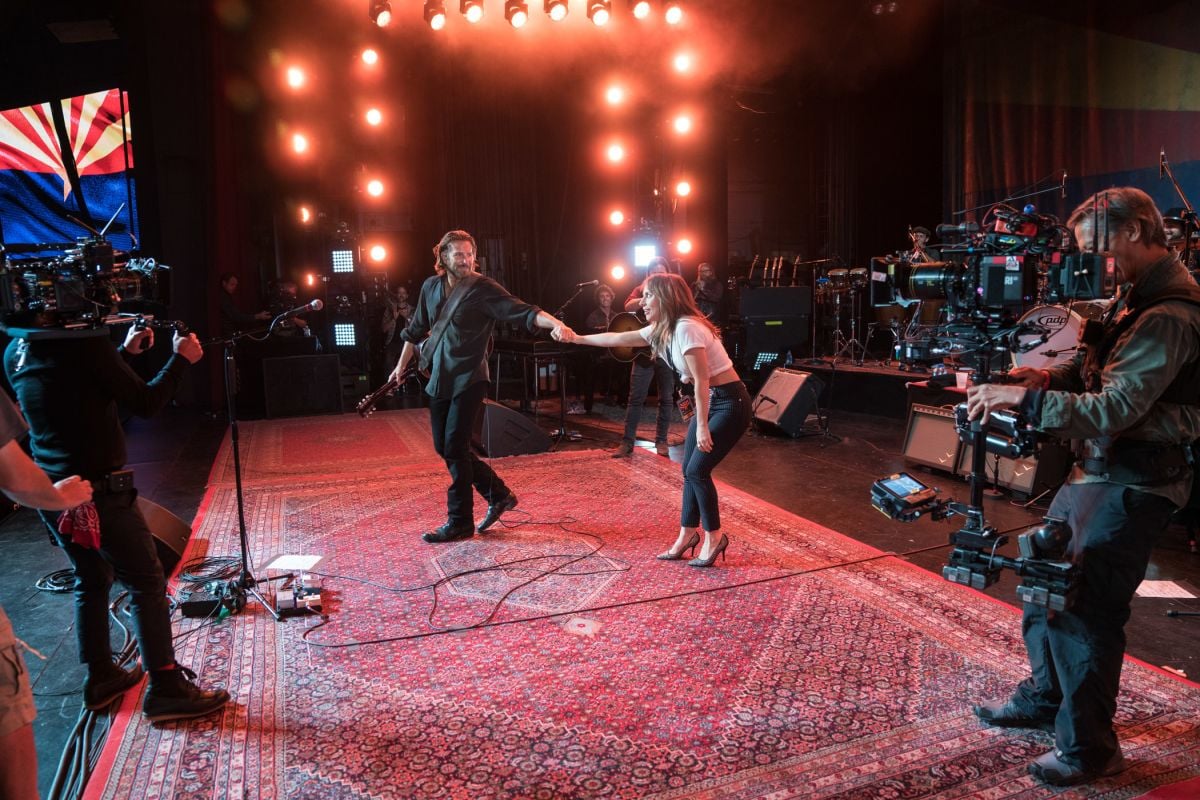
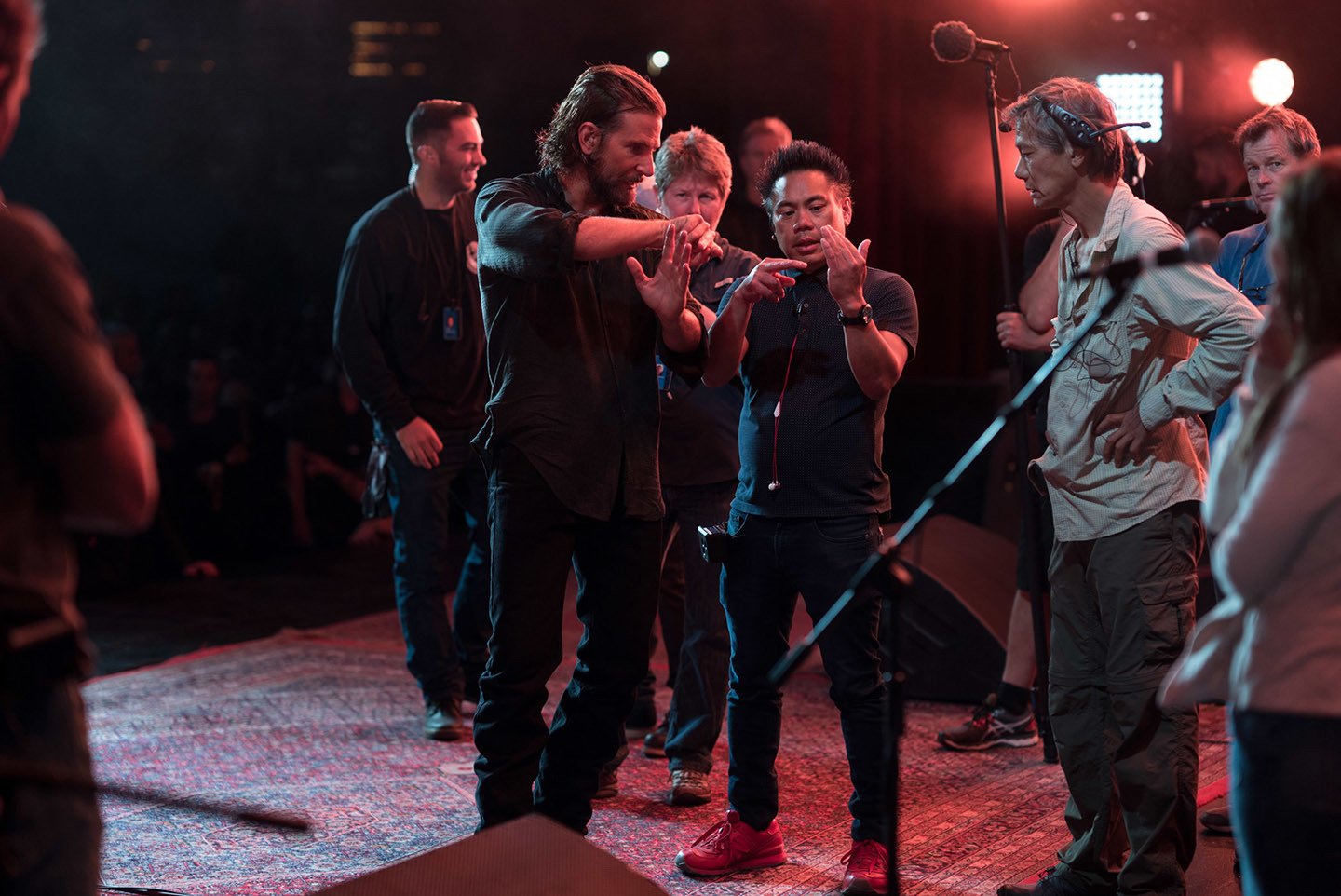
The cinematographer took advantage of the time Cooper was using to work on the movie’s music to help pinpoint the visual tone, bringing a camera to the director’s house to see how Cooper would look in different situations. “A lot of ideas came out of that,” Libatique recalls. “Bradley has a red sign in his house that casts a red light near his kitchen, exactly like a sign that’s in the film, and that was an inspiration for using color in the stage performances. Things would just happen — I also shot some footage of Bradley in silhouette. We reviewed the footage afterward, and that quick one-day shoot defined how we approached the film.”
That approach involved a combination of having a definitive idea of what each scene should be about with an openness toward where to put the camera and how to stage it. “Bradley is a cross between complete improvisation and complete control over the tone,” Libatique says. “He’s open to everything but very precise. And he wasn’t interested in coverage. Putting the camera in the right place was more important to him than collecting shots.”
The filmmakers’ preference was to place viewers inside the characters’ experience without a heavy reliance on close-ups. “In the Streisand version, there’s a fixation on close-ups,” Libatique observes. “I don’t mean that as a criticism, just an observation. It changes the landscape of each scene when you cut into a close-up where the light has been manipulated. You’re suddenly conscious of the light. Bradley and I wanted our version to feel more rooted in reality and naturalism.
“Visually, I wanted the film to feel like it was Jack’s world when we enter, and Ally just had to exist within it as she starts her rise to fame,” the cinematographer continues. “Then, as she becomes an equal and surpasses him, I wanted everything to build to a larger-than-life feeling, with vivid color. She’s playing in front of tens of thousands of people, and I wanted it to be beautiful, like a drug. Nothing could be better — but then that drug starts to wear off, and in her last scene I just wanted white light. The color represents a manic rock-and-roll lifestyle, and the white light represents a kind of sobriety.”
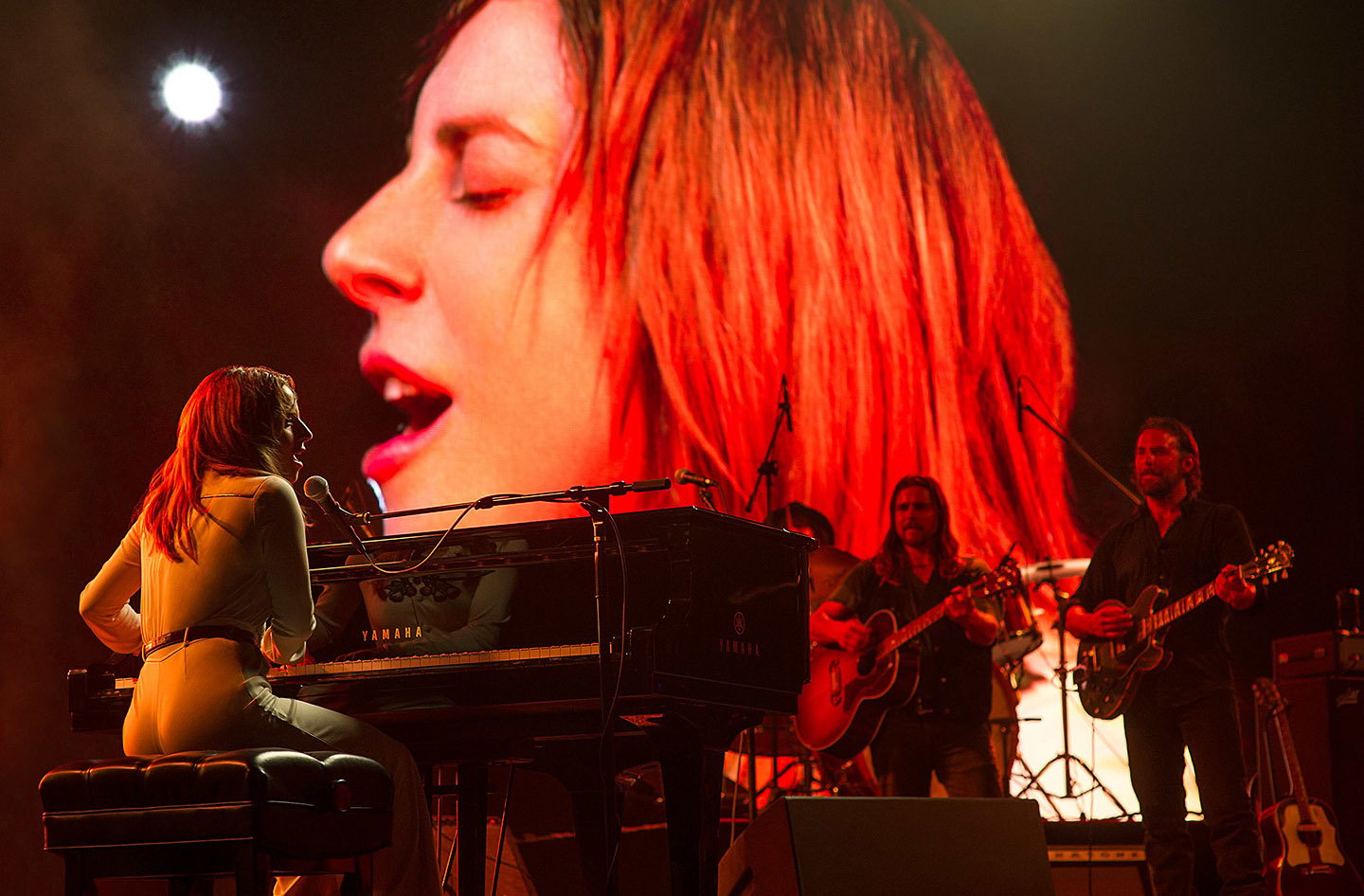
Libatique similarly conveyed a sense of the characters’ progression through his lens selection. “We used all Arri Alexa Mini cameras with a combination of [Cooke/i SF Camtec Vintage Series] anamorphics and Kowa [Cine Prominar] anamorphics,” he explains. “I used the Kowa anamorphic primes for Bradley on stage. I wanted something that would have a lot of imperfections — the flaring, the hazing, all the haphazard things that happen with old glass. I dedicated those lenses to Jack Maine to give all of his stage work that quality, and even when [Ally] started to sing backup and perform with him, I tried to maintain those lenses as much as I could for close-ups, to give the feeling that she was moving into his world. For things that were a little more objective and non-concert-related, I would use the Cooke anamorphics. When his downfall begins, I maintained the Kowas when we were close to him. Then, when it becomes Ally’s story and she has the advantage, I pretty much stuck with the Cookes.”
One of Libatique’s favorite pieces of gear when photographing Cooper was Burbank camera house Camtec’s Color-Con, which the cinematographer describes as “a filter tray with LEDs in the interior of it. We put a [Tiffen] Glimmerglass filter in it, and we were able to adjust the light to haze the image or create a low-contrast feel. It’s sort of like the old days when you would flash film. I used that to maintain the dirtiness and grit of his world in the studio.”
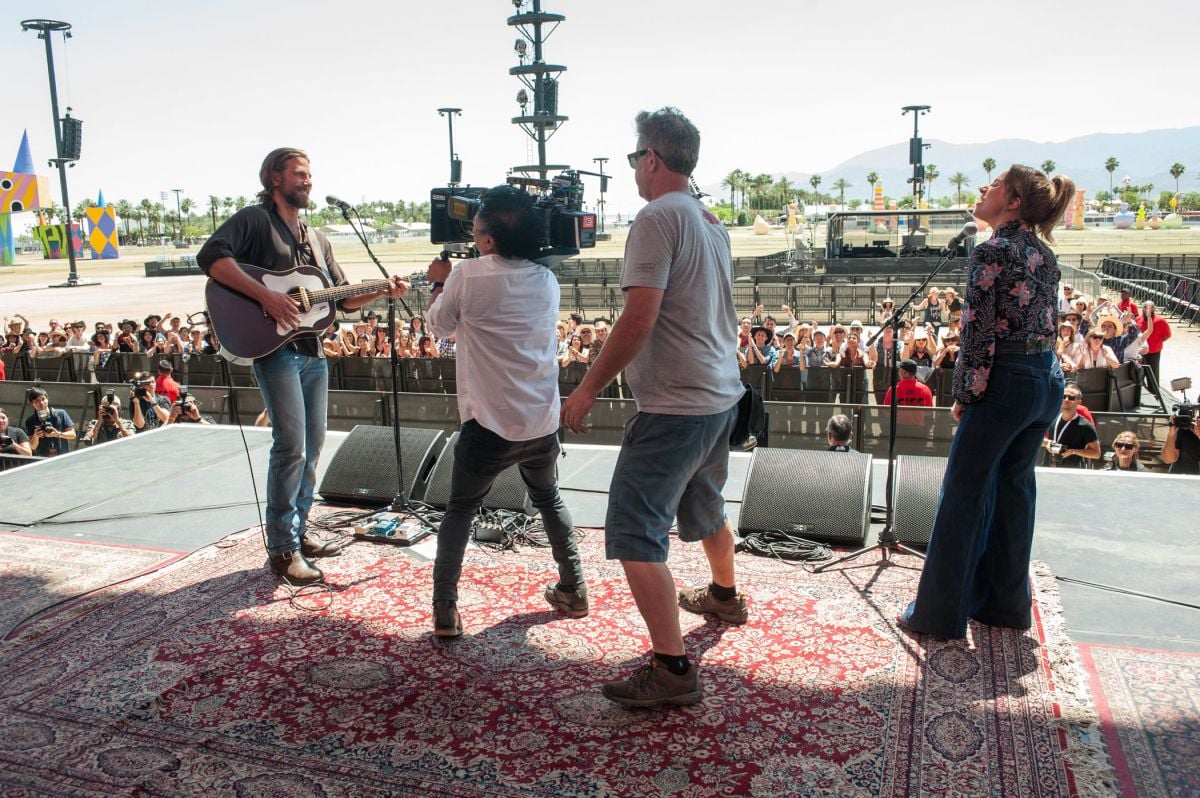
For a scene in which Ally sings a song called “Arizona Sky,” Libatique wanted to bring “her” light onto Jackson’s stage. “Up until this point, she existed in his light, but at that moment she starts to have her own,” the cinematographer explains. “From a nuts and bolts perspective, we actually had to make one for her. This was before [Arri released] the SkyPanel S360, so what we did was take two SkyPanel S60s and butted them together. We created an octagonal Chimera-type soft box that fit around the two SkyPanels, because I wanted to prioritize her character over his — it allowed me to key Ally specifically in her own light. Up until then, she existed in the modulated light of Jack’s background band.”
SkyPanels and other LED fixtures were a common go-to for Libatique and gaffer Jeff Ferrero. “Even in Jack’s house, it was all LED, controlled from a board so we could set levels and orchestrate the light as the camera was moving around,” Libatique notes. “We had complete control even in smaller scenes.”
When shooting a sequence that takes place at a Saturday Night Live taping — shot on the actual SNL set in New York — Libatique was introduced to Astera AX1 PixelTubes by New York gaffer John Velez. The cinematographer subsequently used the PixelTubes through the rest of production. “They’re remote-controlled and battery-operated, so you don’t have to power them,” he explains. “I’d use a lot of those, and a lot of LiteGear LEDs, like LiteMats.”
Lighting-console programmer Eric Androvich adds, “For all of the lighting outside of the concerts, Jeff and Matty used Arri SkyPanel S60-Cs as the main fixture of choice. The key to Jeff’s efficiency on set was the use of wireless DMX technology, namely CRMX from LumenRadio. Nearly every fixture in the truck was DMX-controllable and was ready to go with wireless DMX receivers attached. This meant every light on set could be controlled by the lighting console, which allowed for fast changes of intensity and color. Matty would stay on HME comms at all times with Jeff and myself so he could make small tweaks and subtle lighting changes during takes.”
For certain large concert scenes, the cast and crew had to execute the musical numbers in a matter of minutes, as they were borrowing time during actual live shows at music festivals such as Coachella and Stagecoach. “Our ability to add lighting depended on the stage,” Libatique explains. “The main stage at Coachella was an exercise in subtraction, while some of the smaller stages at Coachella and Stagecoach gave us the ability to rig some specific units to augment their rig for our purposes. We also shot at Glastonbury, but we had no control of the light.”
When they did have control, he continues, “We had to shape [the light] on the fly, changing lighting cues mid-song,” the cinematographer notes. “Usually I like to start with a master so I can understand where the light falls, but here we hardly ever did anything wide — and if we did, it was behind the actors.
“I get nervous every time I do stage work or music, because it’s so easy for the light to get uncontrollable,” he continues. “For each scene I would say, ‘Okay, what’s my biggest problem here?’ and shape the light around that. The good thing is that we had a visual language established, and within that language we were able to improvise. We could change things on the day and pivot to something else, and tonally it would make sense.”
Although several musical numbers were shot at these festivals, Androvich notes that “the majority of the concert scenes were created from scratch, taking many days to rig and multiple days to shoot.” In all cases, the filmmakers strove to be as realistic as possible with their lighting design for the concert scenes. “Lighting fixtures were chosen and placed [as though we were] designing a live show or concert for an audience,” Androvich explains. “From there, we organized the lights into groups — downstage, upstage, stage left and stage right — which I would fade up or down based on the camera position to keep the performers in contrast and to avoid camera shadow. During many of the performances, which were mostly shot in one continuous take, I would have to keep my eyes on two, three or sometimes four cameras at a time in order to maintain Matty’s preferred level of contrast on the performers while simultaneously running the color changes and effects. Matty was on HME comms with me so he could directly call out any last-second lighting changes or adjustments as well.”
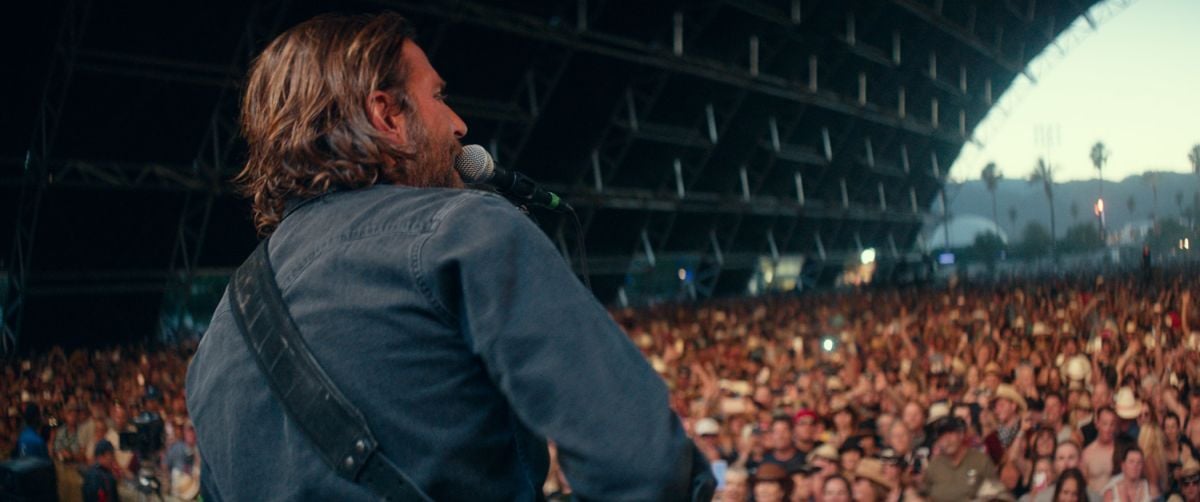
Androvich notes that a workhorse for most of the concerts was Martin’s Mac Aura, a versatile LED fixture that can serve as both a wash and a beam source. “For the concert scene at L.A.’s Greek Theatre, we had more than 160 Mac Auras alone,” he says. “They’re responsible for the rich, saturated colors you see on the performers. The rest of the concert lighting was rounded out by [Philips] Vari-Lite spots and washes, Arri SkyPanels, Clay Paky Sharpy [units], and Ayrton MagicPanel-R lights — Matty saw [the latter] at Coachella during the beginning of the shoot and liked their effect. We also employed a couple PRG Bad Boy moving lights with the GroundControl Followspot System, which allowed follow-spot operators to aim the lights remotely.
“Our very first week of shooting took place during Coachella,” Androvich recounts. “It was one of our biggest challenges, but those scenes also set the tone for the concert lighting throughout the rest of the shoot. We showed up at our night concert location in the Mojave Tent, only to discover that the Coachella lighting programmer who was responsible for that lighting rig would not be there. Thankfully, the stage techs were very accommodating and gave us full access to the whole lighting rig and the console that was there to control it. As was the case with almost every Coachella stage, the lighting was controlled by a GrandMA2 lighting console, which luckily is the same console I use. With the few hours I had before filming was to begin, I was able to familiarize myself with the fixtures that were there, and I modified the lighting programming to suit Matty’s tastes. Everything ended up working out great, and we were able to give Matty everything he asked for — but it was a situation that could have gone very wrong.”
Over the course of those first nights at Coachella, Libatique and Androvich fine-tuned the look they would carry into other concert scenes. “Matty preferred simple changes of contrasting color as opposed to flashy effects,” Androvich says. “He chose primary red and a light cyan as the main colors for Jackson’s performances. As Ally’s career diverges later in the film, we began to give her performances their own colors and added more lighting effects.”
Libatique had chosen the Alexa Minis for their mobility, and the filmmakers covered the concert scenes with three cameras on average, with a fourth added for certain moments. All cameras recorded ArriRaw. “Lady Gaga sings live,” Libatique notes. “She refuses to lip-sync. I didn’t want to risk exhausting her, because she delivers 150 percent every time she performs. For her first performance when Jack convinces her to come out on stage, I had four cameras so that I could leapfrog setups. I didn’t want to hose it down — we were being very specific about what we were doing — but I wanted to have cameras ready in different modes. I didn’t want to miss anything with her.”
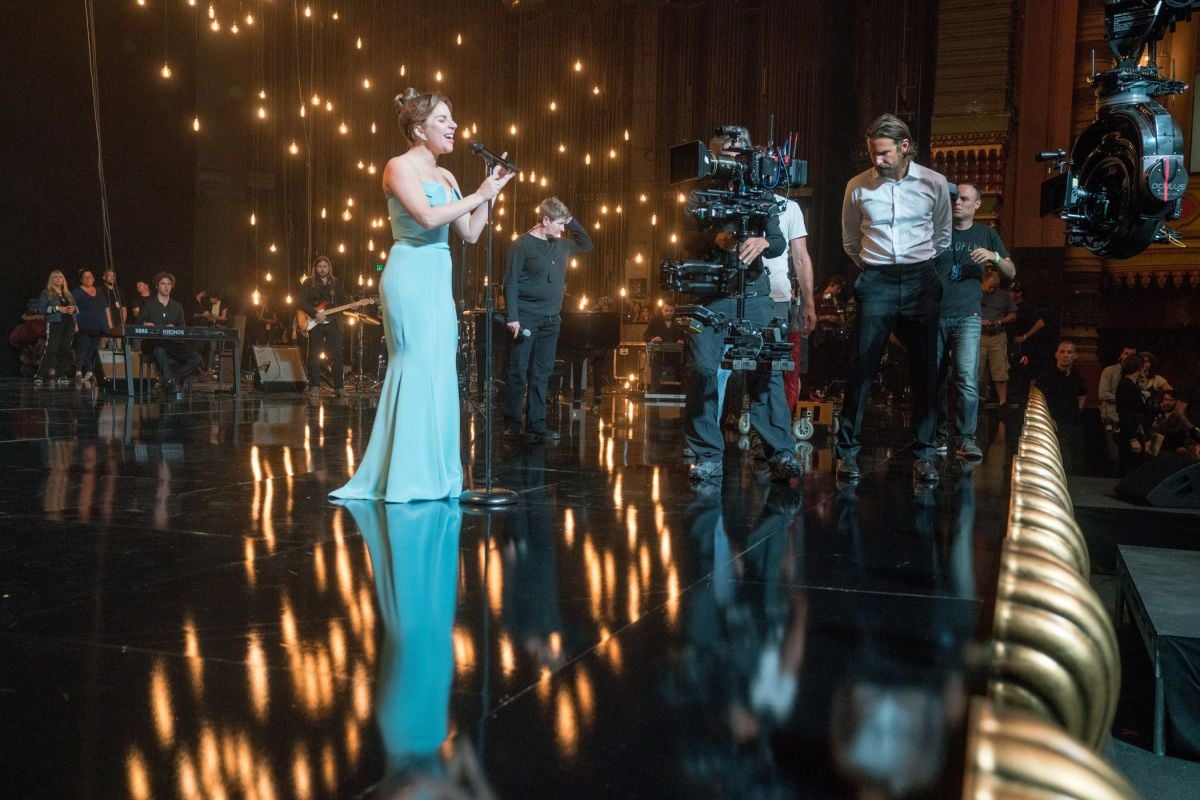
The nature of the production was such that Libatique and his crew, like Cooper, found themselves wearing multiple hats. “Bradley was directing, acting, and thinking about the tone and all kinds of other things at the same time,” the cinematographer reflects. “Although I operated most of the handheld on the concert scenes, for the narrative work I sat back and watched all the cameras so I could monitor everything for him. I wanted to be present for him as a partner and take on whatever responsibility he wanted me to take on. He asked me once, ‘Can you just pay attention to see if my voice changes?’ That’s an odd thing to ask a cinematographer, but he was affecting his voice for the character and didn’t want it to fall out. Maybe once or twice I said, ‘I think that one sounded like the real you,’ and he would go back and do another one to make sure he sounded like Jack.
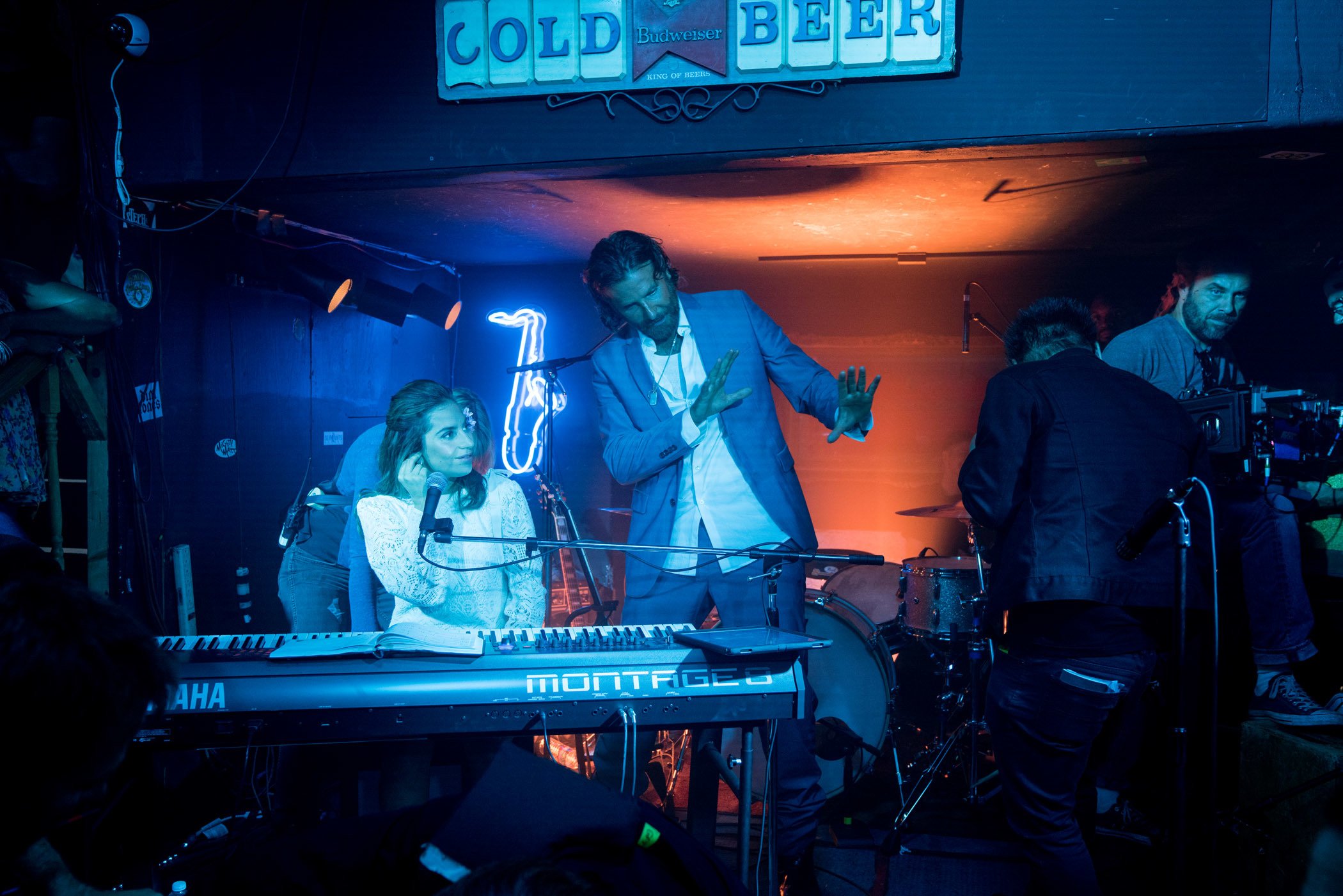
“It was kind of freeing,” he continues, “because I didn’t fixate on the light and on the composition like I usually do. And if I’m not paying attention to light and composition because I’m paying attention to something else for Bradley, then somebody else is paying attention to something for me. I had the benefit of working with people I’m really familiar with, so I had a lot of support and was able to broaden my attention to other things.”
Color grading for A Star Is Born was performed at Company 3 with senior colorist and ASC associate member Stefan Sonnenfeld. “Bradley really wanted the film to look like it looked when we were shooting it, so the major thing [in the final grade] was just to maintain the look and not alter it too much,” Libatique says.

He adds that throughout post, Cooper was “relentless in trying to make things better. I’ve probably seen five very different cuts of the film, because he works and works and works. After a while it’s like one of those situations on Top Chef — ‘Put your knives down!’ He’s a great leader because he encourages everyone to think.”
“I don’t want to leave any stone unturned at any stage of the process,” the director offers. “I want everybody’s opinion, and everybody’s opinion has merit.” It’s an approach that resulted in what Cooper describes as “a beautiful collaboration” with Libatique and his crew. “I can’t say enough about these guys and what they contributed to the movie.”
Libatique has earned an ASC Award nomination for his outstanding camerawork.






